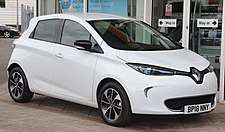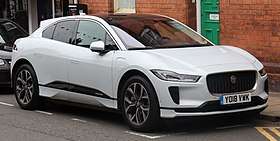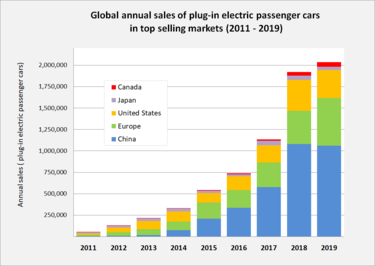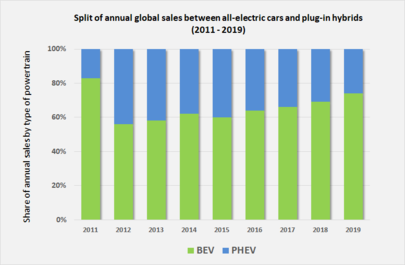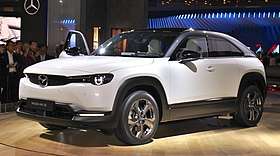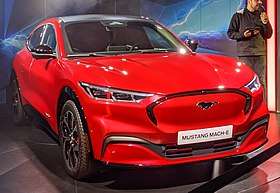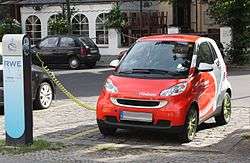Electric car
An electric car is an automobile that is propelled by one or more electric motors, using energy stored in rechargeable batteries. The first practical electric cars were produced in the 1880s.[1] Electric cars were popular in the late 19th century and early 20th century, until advances in internal combustion engines, electric starters in particular, and mass production of cheaper petrol (gasoline) and diesel vehicles led to a decline in the use of electric drive vehicles.
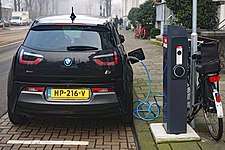
| Part of a series about |
| Sustainable energy |
|---|
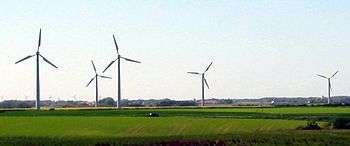 |
| Overview |
| Energy conservation |
| Renewable energy |
| Sustainable transport |
|
From 2008, a renaissance in electric vehicle manufacturing occurred due to advances in batteries, and the desire to reduce greenhouse gas emissions and improve urban air quality.[2] Charging an electric car can be done at a variety of charging stations, these charging stations can be installed in both houses and public areas.[3]
Several countries have established government incentives for plug-in electric vehicles, tax credits, subsidies, and other non-monetary incentives, and long term policies to promote the adoption of electric vehicles. Compared with internal combustion engine cars, electric cars are quieter, have no tailpipe emissions, and lower emissions in general.[4]
The Tesla Model 3 was the world's best selling EV from 2018 to 2019 and had a maximum electric range of 500 km (310 miles) according to the EPA.[5][6][7] The Model 3 became the world's all-time best selling electric car by early 2020.[8]
As of December 2019, the global stock of pure electric passenger cars totaled 4.8 million units, representing two-thirds of all plug-in passenger cars in use. Over half (54%) of the world’s all-electric car fleet was in China in 2019.[9] Despite the rapid growth experienced, the global stock of plug-in electric cars represented just about 1 out of every 250 vehicles (0.40%) on the world's roads by the end of 2018.[10]
The plug-in car market is shifting towards fully electric battery vehicles, as the global ratio between annual sales of battery electric vehicles (BEVs) and plug-in hybrid electric vehicles (PHEVs) rose from 56:44 in 2012, to 60:40 in 2015, and 74:26 in 2019.[11][12]
Terminology


Electric cars are a variety of electric vehicle (EV). The term "electric vehicle" refers to any vehicle that uses electric motors for propulsion, while "electric car" generally refers to highway-capable automobiles powered by electricity. Low-speed electric vehicles, classified as NEVs in the United States,[13] and as electric motorised quadricycles in Europe,[14] are plug-in electric-powered microcars or city cars with limitations in terms of weight, power and maximum speed that are allowed to travel on public roads and city streets up to a certain posted speed limit, which varies by country.
While an electric car's power source is not explicitly an on-board battery, electric cars with motors powered by other energy sources are typically referred to by a different name. An electric car carrying solar panels to power it is a solar car, and an electric car powered by a gasoline generator is a form of hybrid car. Thus, an electric car that derives its power from an on-board battery pack is a form of battery electric vehicle (BEV). Most often, the term "electric car" is used to refer to battery electric vehicles, but may also refer to plug-in hybrid electric vehicles (PHEV).
History
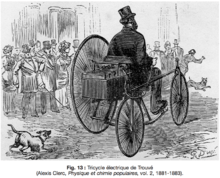

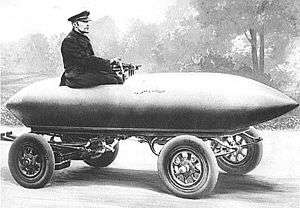
.jpg)
The invention of the first model electric predecessor vehicle is attributed to various people.[16] In 1828, the Hungarian Ányos Jedlik invented an early type of electric motor, and created a small model car powered by his new motor. Between 1832 and 1839, the Scot Robert Anderson built a crude electric-powered carriage, powered by non-rechargeable primary power cells.[17] In 1834, Vermont blacksmith Thomas Davenport built a similar contraption which operated on a short, circular, electrified track.[18] The following year, in 1835, Professor Sibrandus Stratingh of Groningen (The Netherlands) and his assistant Christopher Becker from Germany also created a small-scale electric car, powered by non-rechargeable primary cells.[19]
Other prototypes of electric cars were probably built before, but it was not until the batteries were improved by French inventors Gaston Planté (in 1865) and Camille Faure (in 1881) that electric cars really took off.[20]
In November 1881, Gustave Trouvé presented an electric car at the Exposition internationale d'Électricité de Paris.[21]
In 1884, over 20 years before the Ford Model T, Thomas Parker built a practical production electric car in Wolverhampton using his own specially designed high-capacity rechargeable batteries, although the only documentation is a photograph from 1895 (see below).[22][23][24] The Flocken Elektrowagen of 1888 was designed by German inventor Andreas Flocken and is regarded as the first real electric car.[25][26][27] Electric cars were among the preferred methods for automobile propulsion in the late 19th century and early 20th century, providing a level of comfort and ease of operation that could not be achieved by the gasoline cars of the time.[28] The electric vehicle stock peaked at approximately 30,000 vehicles at the turn of the 20th century.[29]
In 1897, electric cars found their first commercial use as taxis in Britain and the US. In London, Walter Bersey's electric cabs were the first self-propelled vehicles for hire at a time when cabs were horse-drawn.[30] In New York City, a fleet of twelve hansom cabs and one brougham, based on the design of the Electrobat II, were part of a project funded in part by the Electric Storage Battery Company of Philadelphia.[31] During the 20th century, the main manufacturers of electric vehicles in the US were Anthony Electric, Baker, Columbia, Anderson, Edison, Riker, Milburn, Bailey Electric, Detroit Electric and others. Unlike gasoline-powered vehicles, the electric ones were less noisy, and did not require gear changes.[32][33]
Advances in internal combustion engines (ICE) in the first decade of the 20th century lessened the relative advantages of the electric car. Their much quicker refueling times, and cheaper production costs, made them more popular. However, a decisive moment was the introduction in 1912 of the electric starter motor that replaced other, often laborious, methods of starting the ICE, such as hand-cranking.[34]
Six electric cars held the land speed record.[35] The last of them was the rocket-shaped La Jamais Contente, driven by Camille Jenatzy, which broke the 100 km/h (62 mph) speed barrier by reaching a top speed of 105.88 km/h (65.79 mph) on 29 April 1899.
Modern electric cars
The emergence of metal-oxide-semiconductor (MOS) technology led to the development of modern electric road vehicles.[36] The MOSFET (MOS field-effect transistor, or MOS transistor), invented by Mohamed M. Atalla and Dawon Kahng at Bell Labs in 1959,[37][38] led to the development of the power MOSFET by Hitachi in 1969,[39] and the single-chip microprocessor by Federico Faggin, Marcian Hoff, Masatoshi Shima and Stanley Mazor at Intel in 1971.[40] The power MOSFET and the microcontroller, a type of single-chip microprocessor, led to significant advances in electric automobile technology. MOSFET power converters allowed operation at much higher switching frequencies, made it easier to drive, reduced power losses, and significantly reduced prices, while single-chip microcontrollers could manage all aspects of the drive control and had the capacity for battery management.[36] Another important technology that enabled modern highway-capable electric cars is the lithium-ion battery,[41] invented by John Goodenough, Rachid Yazami and Akira Yoshino in the 1980s,[42] which was responsible for the development of electric cars capable of long-distance travel.[41]
In the early 1990s, CARB began a push for more fuel-efficient, lower-emissions vehicles, with the ultimate goal being a move to zero-emissions vehicles such as electric vehicles.[43][44] In response, automakers developed electric models, including the Chrysler TEVan, Ford Ranger EV pickup truck, GM EV1, and S10 EV pickup, Honda EV Plus hatchback, Nissan Altra EV miniwagon, and Toyota RAV4 EV. Both US Electricar and Solectria produced 3-phase AC Geo-bodied electric cars with the support of GM, Hughes, and Delco. These early cars were eventually withdrawn from the U.S. market.[45]
California electric automaker Tesla Motors began development in 2004 on what would become the Tesla Roadster (2008), which was first delivered to customers in 2008. The Roadster was the first highway legal all-electric car to use lithium-ion battery cells, and the first production all-electric car to travel more than 320 km (200 miles) per charge.[46] The Mitsubishi i-MiEV, launched in 2009 in Japan, was the first highway legal series production electric car,[47] and also the first all-electric car to sell more than 10,000 units, including the models badged in Europe as Citroën C-Zero and Peugeot iOn. The record, officially registered by Guinness World Records, was reached in February 2011. Several months later, the Nissan Leaf, launched in 2010, surpassed the i MiEV as the all-time best selling all-electric car.[48]
Tesla global sales passed 250,000 units in September 2017.[49][50] The Renault–Nissan–Mitsubishi Alliance achieved the milestone of 500,000 electric vehicles sold in October 2017.[51] Tesla sold its 200,000th Model S in the fourth quarter of 2017.[52] Global Leaf sales passed 300,000 units in January 2018, keeping its record as the world's top selling plug-in electric car ever.[53] Tesla delivered its 100,000th Model 3 in October 2018.[54]
Many countries have set goals to ban the sales of gasoline- and diesel-powered vehicles in the future, notably: Norway by 2025, Denmark by 2030, China by 2030, India by 2030, Germany by 2030, France by 2040, and Britain by 2040 or 2050.[55][56][57] Similarly, more cities around the world have begun transitioning public transportation towards electric vehicles than previously was the case.[58]
As of June 2019, the Nissan Leaf listed as the best-selling highway-capable electric car ever with more than 400,000 units sold worldwide,[59] followed by the Tesla Model S with 263,500 units as of December 2018.[52][60][61][62][63] which have EPA-rated ranges reaching up to 243 km (151 miles) and 600 km (370 miles) respectively.[64][65][66] In July 2019, US-based Motor Trend magazine awarded the fully electric Tesla Model S as the "ultimate car of the year".[67]
As of March 2020, the Tesla Model 3 is the world's all-time best-selling electric car, with more than 500,000 units delivered.[8] Nissan reported Leaf global sales totaling 450,000 units in January 2020.[68]
Economics
Total cost of ownership
As of 2019, electric cars are less expensive to run than comparable internal combustion engine cars due to the lower cost of maintenance and energy,[69] but cost more to buy new.[70] However, Matthew Debord states, "the cost-of-ownership analysis has to be seen as somewhat unpredictable today, mainly because ... we don’t know how much it will ultimately cost to replace batteries on ageing EVs."[71]
The greater the distance driven per year, the more likely the total cost of ownership for an electric car will be less than for an equivalent ICE car.[72] However, this may only be achievable for EVs with adequate battery temperature regulation, which is critical for battery longevity. It also varies by country depending on the taxes and subsidies on different types of energy and car, and in some countries it may vary by city, as different cities within the country have different charges for entering the city with the same type of car; for example, the UK city of London charges ICE cars more than Birmingham does.[73]
Purchase cost
Several national and local governments have established EV incentives to reduce the purchase price of electric cars and other plug-ins.[74][75][76][77]
When designing an electric vehicle, manufacturers may find that for low production, converting existing platforms may be cheaper as development cost is lower, however, for higher production, a dedicated platform may be preferred to optimize design, and cost.[78]
Almost 80% of electric vehicles in the U.S. are leased, while the lease rate for the country's entire fleet is about 30%.[79] In early 2018, electric compact cars of 2014 are worth 23 percent of their original sticker price, as comparable cars with combustion engines worth 41 percent.[79]
As of 2019 the electric vehicle battery is a significant part of the total cost of the car.
Operating cost
According to a study done in 2018, examining only fuel costs, the average fueling cost of an electric vehicle in the United States is $485 per year, as opposed to an internal combustion engine's $1,117 per year. Estimated gasoline costs varied from $993 in Alabama to $1,509 in Hawaii. Electric costs varied from $372 in Washington to $1,106 in Hawaii.[80]
Environmental aspects
Electric cars have several benefits over conventional internal combustion engine automobiles, including a significant reduction of local air pollution, as they do not directly emit pollutants such as particulates (soot), volatile organic compounds, hydrocarbons, carbon monoxide, ozone, lead, and various oxides of nitrogen.[83][84][85]
Depending on the production process and the source of the electricity to charge the vehicle, emissions may be partly shifted from cities to the material transportation, production plants and generation plants.[43] The amount of carbon dioxide emitted depends on the emissions of the electricity source, and the efficiency of the vehicle. For electricity from the grid, the emissions vary significantly depending on your region, the availability of renewable sources and the efficiency of the fossil fuel-based generation used.[86][87][88]
The same is true of ICE vehicles. The sourcing of fossil fuels (oil well to tank) causes further damage and use of resources during the extraction and refinement processes, including high amounts of electricity.
The cost of installing charging infrastructure has been estimated to be repaid by health cost savings in less than 3 years.[89]
In December 2016, Nissan reported that Leaf owners worldwide achieved the milestone of 3 billion kilometers (1.9 billion miles) driven collectively through November 2016.[90]
Lithium availability

It is estimated that there are sufficient lithium reserves to power 4 billion electric cars.[93][94] Most electric cars use a lithium-ion battery and an electric motor that uses rare-earth elements. The demand for lithium, heavy metals, and other elements (such as neodymium, boron and cobalt) required for the batteries and powertrain is expected to grow significantly due to the future sales increase of plug-in electric vehicles in the mid and long term.[95][96] Some of the largest world reserves of lithium and other rare metals are located in countries with strong resource nationalism, unstable governments or hostility to various overseas interests, raising concerns about the risk of replacing dependence on foreign oil with a new dependence on hostile countries to supply strategic materials.[91][95][96][97]
Performance
Acceleration and drivetrain design
.jpg)
Electric motors can provide high power-to-weight ratios, batteries can be designed to supply the currents needed to support these motors. Electric motors have flat torque curve down to zero speed. For simplicity and reliability, many electric cars use fixed-ratio gearboxes and have no clutch.
Many electric cars have higher acceleration than average internal combustion cars, largely due to reduced drivetrain frictional losses, and the more quickly available torque of an electric motor.[99] However Neighborhood Electric Vehicles (NEVs) may have a low acceleration due to their relatively weak motors.
Electric vehicles can also use a direct motor-to-wheel configuration that increases the available power. Having motors connected directly to each wheel simplifies using the motor for both propulsion and braking, increasing traction.[100][101][102] Electric vehicles that lack an axle, differential, or transmission can have less drive-train inertia.
For example, the Venturi Fetish delivers supercar acceleration despite a relatively modest 220 kW (300 hp), and top speed of around 160 km/h (100 mph). Some DC-motor-equipped drag racer EVs have simple two-speed manual transmissions to improve top speed.[103] The 2008 Tesla Roadster 2.5 Sport can accelerate from 0 to 97 km/h (0 to 60 mph) in 3.7 seconds with a motor rated at 215 kW (288 hp).[104] Tesla Model S P100D (Performance / 100kWh / 4-wheel drive) is capable of 2.28 seconds for 0–60 mph at a price of $140,000.[105] As of May 2017, the P100D is the second quickest production car ever built, taking only 0.08 seconds longer for 0–97 km/h (0–60 mph), compared to a $847,975 Porsche 918 Spyder.[106] The concept electric supercar Rimac Concept One claims it can go from 0–97 km/h (0–60 mph) in 2.5 seconds. Tesla claims the upcoming Tesla Roadster could go 0–60 mph (0–97 km/h) in 1.9 seconds.[107]
Energy efficiency
.pdf.jpg)
Internal combustion engines have thermodynamic limits on efficiency, expressed as fraction of energy used to propel the vehicle compared to energy produced by burning fuel. Gasoline engines effectively use only 15% of the fuel energy content to move the vehicle or to power accessories, and diesel engines can reach on-board efficiency of 20%, while electric vehicles have efficiencies of 69-72%, when counted against stored chemical energy, or around 59-62%, when counted against required energy to recharge.[108][109]
Electric motors are more efficient than internal combustion engines in converting stored energy into driving a vehicle. However, they are not equally efficient at all speeds. To allow for this, some cars with dual electric motors have one electric motor with a gear optimised for city speeds and the second electric motor with a gear optimised for highway speeds. The electronics select the motor that has the best efficiency for the current speed and acceleration.[110] Regenerative braking, which is most common in electric vehicles, can recover as much as one fifth of the energy normally lost during braking.[43][108] Efficiency increases when renewable electricity is used[111]
Cabin heating and cooling
While heating can be provided with an electric resistance heater, higher efficiency and integral cooling can be obtained with a reversible heat pump. PTC junction cooling[112] is also attractive for its simplicity — this kind of system is used, for example, in the 2008 Tesla Roadster.
To avoid using part of the battery's energy for heating and thus reducing the range, some models allow the cabin to be heated while the car is plugged in. For example, the Nissan Leaf, the Mitsubishi i-MiEV, Renault Zoe and the Tesla Model S and 3 can be pre-heated while the vehicle is plugged in.[113][114][115]
Some electric cars, for example the Citroën Berlingo Electrique, use an auxiliary heating system (for example gasoline-fueled units manufactured by Webasto or Eberspächer) but sacrifice "green" and "Zero emissions" credentials. Cabin cooling can be augmented with solar power external batteries and USB fans or coolers, or by automatically allowing outside air to flow through the car when parked. Two models of the 2010 Toyota Prius include this feature as an option.[116]
Safety
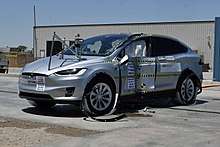
The safety issues of BEVs are largely dealt with by the international standard ISO 6469. This document is divided in three parts dealing with specific issues:
- On-board electrical energy storage, i.e. the battery[117]
- Functional safety means and protection against failures[118]
- Protection of persons against electrical hazards[119]
Risk of fire
Like their internal combustion engine (ICE) counterparts, electric vehicle batteries can catch fire after a crash or mechanical failure.[120] Plug-in electric vehicle fire incidents have occurred, albeit less per mile than ICE vehicles.[121] The first modern crash-related fire was reported in China in May 2012, after a high-speed car crashed into a BYD e6 taxi in Shenzhen.[122] The second reported incident occurred in the United States on 1 October 2013, when a Tesla Model S caught fire over ten minutes after the electric car hit metal debris on a highway in Kent, Washington state, and the debris punctured one of 16 modules within the battery pack.[123][124] A third reported fire occurred on 18 October 2013 in Merida, Mexico. In this case the vehicle was being driven at high speed through a roundabout and crashed through a wall and into a tree. The fire broke out several minutes after the driver exited the vehicle.
In the United States, General Motors ran in several cities a training program for firefighters and first responders to demonstrate how to safely disable the Chevrolet Volt's powertrain and its 12 volt electrical system. The Volt's high-voltage system is designed to shut down automatically in the event of an airbag deployment, and to detect a loss of communication from an airbag control module.[125][126] GM also made available an Emergency Response Guide for the 2011 Volt for use by emergency responders. The guide also describes methods of disabling the high voltage system and identifies cut zone information.[127] Nissan also published a guide for first responders that details procedures for handling a damaged 2011 Leaf at the scene of an accident, including a manual high-voltage system shutdown, rather than the automatic process built-in the car's safety systems.[128][129]
Vehicle safety
The weight of the batteries themselves usually makes an EV heavier than a comparable gasoline vehicle, in a collision, the occupants of a heavy vehicle will on average, suffer fewer and less serious injuries than the occupants of a lighter vehicle; therefore, the additional weight brings safety benefits (to the occupant)[130] despite having a negative effect on the car's performance.[131] Depending on where the battery is located, it may lower the center of gravity, increasing driving stability, lowering the risk of an accident through loss of control. An accident in a 2,000 lb (900 kg) vehicle will on average cause about 50% more injuries to its occupants than a 3,000 lb (1,400 kg) vehicle.[132]
Some electric cars use low rolling resistance tires, which typically offer less grip than normal tires.[133][134][135] The Insurance Institute for Highway Safety in America had condemned the use of low speed vehicles and "mini trucks," called NEVs when powered by electric motors, on public roads.[136] Mindful of this, several companies (Tesla Motors, BMW, and Uniti) have succeeded in keeping the body light, while making it very strong.[137]
Controls
As of 2018, most electric cars have similar driving controls to that of a car with a conventional automatic transmission. Even though the motor may be permanently connected to the wheels through a fixed-ratio gear and no parking pawl may be present, the modes "P" and "N" are often still provided on the selector. In this case the motor is disabled in "N" and an electrically actuated hand brake provides the "P" mode.
In some cars the motor will spin slowly to provide a small amount of creep in "D", similar to a traditional automatic.[138]
When an internal combustion vehicle's accelerator is released, it may slow by engine braking depending on the type of transmission, and mode. An EV would coast when the accelerator is similarly released, but it may be equipped with regenerative braking that mimics a familiar response of slowing the vehicle and also recharging the battery to an extent.[139] Regenerative braking systems also decrease the use of the conventional brakes similarly as engine braking would in an internal combustion vehicle, reducing brake wear and maintenance costs.
Batteries
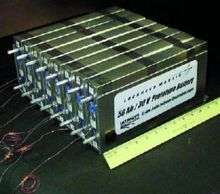
Lithium-based batteries are often used for their high power and energy density, although they eventually wear out.[140] Other battery types, such as nickel metal hydride (NiMH), which have a poorer power-to-weight ratio than lithium ion, but are cheaper. Batteries with different chemical compositions are in development such as zinc-air battery that could be much lighter.
Range
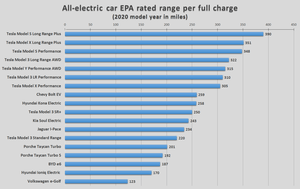

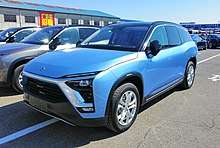
The range of an electric car depends on the number and type of batteries used, and as with all vehicles, the weight and type of vehicle, performance requirements, and the weather.[142]
The reported range of production electric vehicles in 2017 ranged from 100 km (60 miles) (Renault Twizy) to 540 km (340 miles) (Tesla Model S 100D).[143] Real-world range tests conducted by What Car in early 2019 found that the highest real-world range was 417 km (259 miles) (Hyundai Kona).[144]
The majority of electric cars are fitted with a display of expected range. This may take into account many factors of how the vehicle is being used, and what the battery is powering. However, since factors can vary over the route, the estimate can vary from the actual achieved range. The display allows the driver to make informed choices about driving speed and whether to stop at a charging point en route. Some roadside assistance organizations offer charge trucks to recharge electric cars in case of emergency.[145]
A study in 2016 stated that 87% of US vehicle-days could be met by current affordable electric cars.[146][147]
Charging
Electric cars are typically charged overnight from a charging station installed in the owner's house, or from faster charging stations found in businesses and public areas.[148]
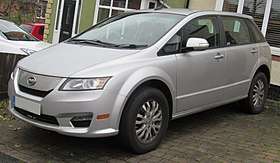
Compared to fossil fuel vehicles, the need for charging using public infrastructure is diminished because of the opportunities for home charging; vehicles can be plugged in and begin each day with a full charge, assuming the home charging station can charge quickly enough. An overnight charge of 8 hours using a 120-volt AC outlet will provide around 65 km (40 miles) of range, while a 240-volt AC outlet will provide approximately 290 km (180 miles).[149]
Charging an electric vehicle using public charging stations takes longer than refueling a fossil fuel vehicle. The speed at which a vehicle can recharge depends on the charging station's charging speed and the vehicle's own capacity to receive a charge. Connecting a vehicle that can accommodate very fast charging to a charging station with a very high rate of charge can refill the vehicle's battery to 80% in 15 minutes.[150] Vehicles and charging stations with slower charging speeds may take as long as an hour to refill a battery to 80%. As with a mobile phone, the final 20% takes longer because the systems slow down to fill the battery safely and avoid damaging it.
Some companies have been experimenting with battery swapping to substantially reduce the effective time to recharge.[151]
Electric vehicle charging plugs are not yet universal throughout the world. Europe uses the CCS standard, while CHAdeMO is used in Japan, and a GB/T standard is used in China. The United States has no de facto standard, with a mix of CCS, Tesla Superchargers, and CHAdeMO charging stations. However vehicles using one type of plug are generally able to charge at other types of charging stations with the use of plug adapters.[152]
Range extender option

Some electric cars, such as the BMW i3 have a variant with an optional small petrol/gasoline range extender. The system is intended as an emergency backup to extend range to the next recharging location, and not for long-distance travel.[153]
The range-extender option of the BMW i3 was designed to meet the California Air Resources Board (CARB) regulation for an auxiliary power unit (APU) called REx. According to rules adopted in March 2012 by CARB, the 2014 BMW i3 with a REx unit fitted was the first car ever to qualify as a range-extended battery-electric vehicle or "BEVx".[154]
Lifespan
As with all lithium-ion batteries, electric vehicle batteries may degrade over long periods of time, especially if they are frequently overcharged, however, this may take at least several years before being noticeable.[155]
However, Nissan stated in 2015 that thus far only 0.01 percent of batteries had to be replaced because of failures or problems, and then only because of externally inflicted damage. The vehicles that had already covered more than 200,000 km (124,274 mi), have no problems with the battery.[156]
Future
- Autonomous park-and-charge
Volkswagen, in collaboration with six partners, is developing an EU research project that is focused on automating the parking and charging of electric vehicles. The objective of this project is to develop a smart car system that allows for autonomous driving in designated areas (e.g. valet parking, park and ride) and can offer advanced driver support in urban environments.[157] Tesla has shown interest in making an arm that automatically charges their vehicles.[158]
- Other methods of energy storage
Experimental supercapacitors and flywheel energy storage devices offer comparable storage capacity, faster charging, and lower volatility. They have the potential to overtake batteries as the preferred rechargeable storage for EVs.[159][160] The FIA included their use in its sporting regulations of energy systems for Formula One race vehicles in 2007 (for supercapacitors) and 2009 (for flywheel energy storage devices).
- Solar cars
Solar cars are electric vehicles powered completely or significantly by direct solar energy, usually, through photovoltaic (PV) cells contained in solar panels that convert the sun's energy directly into electric energy, usually used to charge a battery.
Electric vehicle charging patents
Qualcomm, Hyundai, Ford, and Mitsubishi are the top patent holders of the close to 800 electric vehicle charging patents filed between 2014 and 2017.[161] A majority of patents on electric vehicle charging were filed in Japan between 2014 and 2017. It is followed by the US and then by China.[162]
Infrastructure
Charging station

Battery electric vehicles are most commonly charged from the power grid overnight at the owner's house, provided they have their own charging station. The electricity on the grid is in turn generated from a variety of sources; such as coal, hydroelectricity, nuclear and others. Power sources such as photovoltaic solar cell panels, micro hydro or wind may also be used and are promoted because of concerns regarding global warming.
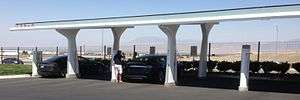
Charging stations can have a variety of different speeds of charging, with slower charging being more common for houses, and more powerful charging stations on public roads and areas for trips.[163] The BMW i3 can charge 0–80% of the battery in under 30 minutes in rapid charging mode.[164] The superchargers developed by Tesla Motors provided up to 130 kW of charging, allowing a 300-mile charge in about an hour.[165]
Connectors
Most electric cars have used conductive coupling to supply electricity for recharging after CARB settled on the SAE J1772-2001 standard[166] as the charging interface for electric vehicles in California in June 2001.[167] In Europe, the ACEA has decided to use the Type 2 connector from the range of IEC_62196 plug types for conductive charging of electric vehicles in the European Union, as the Type 1 connector (SAE J1772-2009) does not provide for three-phase charging.[168]
Another approach is inductive charging using a non-conducting "paddle" inserted into a slot in the car. Delco Electronics developed the Magne Charge inductive charging system around 1998 for the General Motors EV1 that was also used for the Chevrolet S-10 EV and Toyota RAV4 EV vehicles.
Vehicle-to-grid: uploading and grid buffering
During peak load periods, when the cost of generation can be very high, electric vehicles could contribute energy to the grid. These vehicles can then be recharged during off-peak hours at cheaper rates while helping to absorb excess night time generation. Here the batteries in the vehicles serve as a distributed storage system to buffer power.[169]
Currently available electric cars
Highway capable
According to Bloomberg New Energy Finance, as of December 2018, there were almost 180 models of highway-capable all-electric passenger cars and utility vans available for retail sales globally.[170]
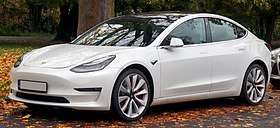
Tesla became the world's leading electric vehicle manufacturer in December 2019, with cumulative global sales of over 900,000 all-electric cars since 2008.[171][172] Tesla listed as the world's top selling plug-in electric car manufacturer both in 2018 and 2019, and both times as a brand and by automotive group.[173][174] Its Model S was the world's top selling plug-in electric car in 2015 and 2016,[176][177] and its Model 3 was the world's best selling plug-in electric car in 2018 and 2019.[12][178] The Tesla Model 3 surpassed the Leaf in early 2020 to become the world's best selling electric car ever, with more than 500,000 sold by March 2020.[8] Tesla produced its 1 millionth electric car in March 2020, becoming the first auto manufacturing to achieved such milestone.[179]
As of December 2019, the Renault–Nissan–Mitsubishi Alliance is one of the world's leading all-electric vehicle manufacturer. Since 2010, the Alliance's global all-electric vehicle sales totaled over 800,000 light-duty electric vehicles through December 2019, including those manufactured by Mitsubishi Motors, now part of the Alliance.[180] Nissan leads global sales within the Alliance, with about 500,000 cars and vans sold by April 2020,[181] followed by the Groupe Renault with more than 273,550 electric vehicles sold worldwide through December 2019, including its Twizy heavy quadricycle.[180] Mitsubishi's only all-electric vehicle is the i-MiEV, with global sales of over 50,000 units by March 2015, accounting for all variants of the i-MiEV, including the two minicab versions sold in Japan.[182]
The Alliance best selling Nissan Leaf was the world's top selling plug-in electric car in 2013 and 2014.[176] Until 2019, the Nissan Leaf was the world's all-time top selling highway legal electric car with global sales of almost 450,000 units by the end of 2019.[8][68] The Renault Kangoo Z.E. utility van is the European leader of the light-duty all-electric segment with global sales of 50,836 units through March 2020.[180][183]
Other leading electric vehicles manufacturers are BAIC Motor, with 480,000 units sold, SAIC Motor with 314,000 units, and Geely with 228,700, all cumulative sales in China as of December 2019.[184] BMW is also a leading plug-in car manufacturer, with over 500,000 plug-in electric cars sold globally by December 2019,[185] but its electrified vehicle lineup only includes one all-electric model, the BMW i3, with 165,000 units delivered up to January 2020, including the REx variants.[186]
The following table lists the all-time best-selling highway-capable all-electric cars with cumulative global sales of around or more than 150,000 units since their inception through March 2020:
| Model | Market launch | Global sales | Cumulative sales through | Sources | |
|---|---|---|---|---|---|
| Since inception | 2019[12][180][187] | ||||
| Tesla Model 3 | Jul 2017 | ~525,000 | 300,000 | Mar 2020 | [63][188][189][190][191] |
| Nissan Leaf | Dec 2010 | 450,000 | 69,800 | Dec 2019 | [68] |
| Tesla Model S | Jun 2012 | ~291,000(2) | ~28,000 | Dec 2019 | [12][52][60][61][62][63] |
| Renault Zoe | Dec 2012 | 203,000 | 48,269 | Mar 2020 | [180][183] |
| BAIC EC-Series | Dec 2016 | 200,200(3) | 27,350 | Dec 2019 | [184][192] |
| BAIC EU-Series | 2016 | 180,400(3) | 111,100 | Dec 2019 | [184] |
| BMW i3 | Nov 2013 | 165,000(4) | 41,800 | Jan 2020 | [186] |
| Tesla Model X | Sep 2015 | ~160,000(2) | ~39,000 | Dec 2019 | [12][60][61][62][63][176][193][194][195][196] |
| Notes: (1) Vehicles are considered highway-capable if able to achieve at least a top speed of 100 km/h (62 mph). (2) Tesla began reporting combined sales of the Model S and X since 1Q 2019. Sales for each model in 2019 are estimates from the source provided (EV Sales) which tracks monthly sales by country.[12] The estimated combined total for Model S/X (67,000) adds up close enough to Tesla's combined reported deliveries for 2019 (66,771).[188] (3) Sales in main China only. (4) BMW i3 sales includes the REx variant (split is not available). | |||||
Retrofitted electric vehicles
Any car can be converted to an electric vehicle using plug and play kits of making custom solutions. The conversion of internal combustion engine cars to electric cars is called Retrofitted Electric Vehicles.
Electric cars by country
Global sales of highway legal plug-in electric passenger cars and light utility vehicles achieved the one million milestone in September 2015, almost twice as fast as hybrid electric vehicles (HEV).[197][198] Cumulative global sales of light-duty all-electric vehicles reached one million units in September 2016.[199][200] Global sales of plug-in passenger cars passed 2 million in December 2016,[201] the 3 million mark in November 2017,[202] the 5 million milestone in December 2018,[203] and totaled 7.2 million units in December 2019.[9] Despite the rapid growth experienced, the global stock of plug-in electric cars represented just about 1 out of every 250 vehicles (0.40%) on the world's roads by the end of 2018.[10]
As of December 2019, the global stock of pure electric passenger cars totaled 4.79 million units, representing two-thirds of all plug-in passenger cars on the world's roads.[9] China has the largest all-electric car fleet in use, with 2.58 million at the end of 2019, more than half (53.9%) of the world’s electric car stock. In addition, there were almost 378,000 electric light commercial vehicles in use by the end of 2019, mainly in China and Europe.[9]
All-electric cars have oversold plug-in hybrids for several years, and by the end of 2019, the plug-in market continues to shift towards fully electric battery vehicles. The global ratio between annual sales of battery BEVs and PHEVs went from 56:44 in 2012, to 60:40 in 2015, and rose to 69:31 in 2018, and to 74:26 in 2019.[11][12][178]
Government policies and incentives
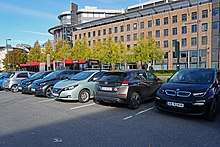
Several national, provincial, and local governments around the world have introduced policies to support the mass market adoption of plug-in electric vehicles. A variety of policies have been established to provide financial support to consumers and manufacturers; non-monetary incentives; subsidies for the deployment of charging infrastructure; and long term regulations with specific targets.[9][210]
Financial incentives for consumers are aim to make electric car purchase price competitive with conventional cars due to the higher up front cost of electric vehicles. There are one-time purchase incentives depending on battery size, such as grants and tax credits, exemptions from import duties, and other fiscal incentives; exemptions from road tolls and congestion charges; and exemption of registration and annual fees.
| Selected countries | Year |
|---|---|
| Norway (100% ZEV sales) | 2025 |
| Denmark | 2030 |
| Iceland | |
| Ireland | |
| Netherlands (100% ZEV sales) | |
| Sweden | |
| United Kingdom | 2040 |
| France | |
| Canada (100% ZEV sales) | |
| Singapore | |
| Germany (100% ZEV sales) | 2050 |
| U.S. (only 10 ZEV states) | |
| Japan (100% HEV/PHEV/ZEV sales) |
The U.S. offers a federal income tax credit up to US$7,500.[77] The UK offers a Plug-in Car Grant up to a maximum of GB£4,500 (US$5,929).[212] France introduced a bonus-malus CO
2 based tax that penalize fossil-fuel vehicle sales.[9][210][213] As of 2020, monetary incentives are also available in several European Union member states, China, Norway, some provinces in Canada, South Korea, India, and other countries.[9]
Among the non-monetary incentives there are several perks such allowing plug-in vehicles access to bus lanes and high-occupancy vehicle lanes, free parking and free charging.[210] In addition, in some countries or cities that restrict private car ownership (purchase quota system for new vehicles), or have implemented permanent driving restrictions (no-drive days), the schemes often exclude electric vehicles from the restrictions to promote their adoption.[213][214][215][216][217][218]
Some government have also established long term regulatory signals with specific targets such as ZEV mandates, national or regional CO
2 emissions regulations, stringent fuel economy standards, and the phase out of internal combustion engine vehicle sales.[9][210] For example, Norway set a national goal that by 2025 all new car sales should be zero emission vehicles (battery electric or hydrogen).[219][220]
EV plans from major manufacturers
Volkswagen plans 27 electric vehicles by 2022, on a dedicated EV platform dubbed "Modular Electric Toolkit" and initialed as MEB.[221] Ford will use Volkswagen's Modular Electric Toolkit to design and build its own fully electric vehicles starting in 2023.[222]
Toyota has developed a global EV platform named e-TNGA that can accommodate a three-row SUV, sporty sedan, small crossover or a boxy compact.[223] Toyota and Subaru will release a new EV on a shared platform.[224] It will be about the size of a Subaru Forester or Toyota RAV4.
As of March 2019, BMW plans 12 all electric vehicles by 2025, using a fifth-generation electric powertrain architecture, which will save weight and cost and increase capacity.[225] BMW has ordered €10 billion worth of battery cells valid from 2021 through 2030.[226][227][228]
Mercedes plans to invest $23 billion on battery cells through 2030 and have 10 all electric vehicles by 2022.[229][230]
In January 2019, GM announced that it plans to make Cadillac its lead electric vehicle brand starting in 2021.[231] GM's "BEV3" next-generation electric vehicle platform is designed to be flexible for use in many different vehicle types, such as front, rear and all-wheel drive configurations.[232]
Ford is planning to release an electric F-150 in the 2021 time frame.[233][234] The Ford Mustang Mach-E, is an electric crossover and with the extended battery range will reach 340 km (210 miles) and up to 480 km (300 miles) if equipped with the rear wheel drive option.[235]
Infiniti announced that by 2021 all newly introduced vehicles will be electric or hybrid.[236]
In January 2020, Hyundai announced it plans 23 pure electric cars by 2025.[237] Hyundai will announce it next generation electric vehicle platform named e-GMP, in 2021.[238]
In January 2019 and updated in April, a Reuters analysis of 29 global automakers concluded that automakers are planning on spending $300 billion over the next 5 to 10 years on electric cars, with 45% of that investment projected to occur in China.[239]
Psychological barriers to adoption
For the past century, most people have driven internal combustion engine (ICE) cars, making them feel common, familiar, and low risk.[240] Even though EV technology has been around for over a century and modern EVs have been on the market for decades, multiple studies show that various psychological factors impair EV adoption.
Range anxiety
Gary L. Brase's 2019 study found that the dominant fear hindering EV adoption was range anxiety.[241] ICE car drivers are accustomed to going on trips without having to plan refueling stops, and may worry that an EV will lack the range to reach their destination or the closest charging station.[242] Range anxiety has been shown to diminish among drivers who have gained familiarity and experience with EVs.[242]
Identity concerns
Brase's study also found that people view driving an EV as an action taken by those with "stronger attitudes in favor of environmental and energy security" or by those that are "attracted to the novelty and status associated with being among the first to adopt new technology".[241] Thus, people may be resistant to EV ownership if they do not consider themselves environmentalists or early adopters of new technology, or do not want others to think of them in this way.
The perceived value associated with driving an EV can also differ by gender. In a 2019 survey conducted in Norway, it was found that people believe women drive EVs for sustainability purposes while men drive EVs for the new technology.[243] The thought process behind this stereotype is that "big and expensive cars are driven by men, while women drive smaller, less valuable cars".[243] Since the reasons behind adopting EVs have a gendered component, it can be argued that some fear driving an EV will result in a disconnect between their gender identity and how they are perceived by others.
See also
- Electric aircraft
- Electric boat
- Electric bus
- Electric car energy efficiency
- Electric motorcycles and scooters
- Electric motorsport
- Electric vehicle warning sounds
- Battery electric vehicle
- Formula E
- List of electric cars currently available
- Phase-out of fossil fuel vehicles
- Solar car
- Vehicle electrification
References
- Roth, Hans (March 2011). Das erste vierrädrige Elektroauto der Welt [The first four-wheeled electric car in the world] (in German). pp. 2–3.
- David B. Sandalow, ed. (2009). Plug-In Electric Vehicles: What Role for Washington? (1st. ed.). The Brookings Institution. pp. 1–6. ISBN 978-0-8157-0305-1. Archived from the original on 28 March 2019. Retrieved 6 February 2011.See Introduction
- "How to charge an electric car". Carbuyer. Archived from the original on 23 April 2018. Retrieved 22 April 2018.
- "Reducing Pollution with Electric Vehicles". www.energy.gov. Archived from the original on 12 May 2018. Retrieved 12 May 2018.
- O'Kane, Sean (22 February 2019). "Tesla's Model 3 was the best-selling EV in the world last year". The Verge. Archived from the original on 19 October 2019. Retrieved 15 December 2019.
- "2019 Tesla Model 3 Long Range". www.fueleconomy.gov. Archived from the original on 14 April 2020. Retrieved 15 December 2019.
- "Tesla Model 3 Equals 1/8 Of World's EV Sales In 2019". CleanTechnica. 6 December 2019. Archived from the original on 8 December 2019. Retrieved 15 December 2019.
- Holland, Maximilian (10 February 2020). "Tesla Passes 1 Million EV Milestone & Model 3 Becomes All Time Best Seller". CleanTechnica. Archived from the original on 12 April 2020. Retrieved 15 May 2020.
- International Energy Agency (IEA), Clean Energy Ministerial, and Electric Vehicles Initiative (EVI) (June 2020). "Global EV Outlook 2020: Enterign the decade of electric drive?". IEA Publications. Retrieved 15 June 2020.CS1 maint: multiple names: authors list (link) See Statistical annex, pp. 247–252 (See Tables A.1 and A.12). The global stock of plug-in electric passenger vehicles totaled 7.2 million cars at the end of 2019, of which, 47% were on the road in China. The stock of plug-in cars consist of 4.8 million battery electric cars (66.6%) and 2.4 million plug-in hybrids (33.3%). In addition, the stock of light commercial plug-in electric vehicles in use totaled 378 thousand units in 2019, and about half a million electric buses were in circulation, most of which are in China.
- Coren, Michael J. (25 January 2019). "E-nough? Automakers may have completely overestimated how many people want electric cars". Quartz. Archived from the original on 5 February 2019. Retrieved 25 January 2019.
The plug-in electric car segment represented just about 1 out of every 250 vehicles on the world's roads by the end of 2018
- Hertzke, Patrick; Müller, Nicolai; Schenk, Stephanie; Wu, Ting (May 2018). "The global electric-vehicle market is amped up and on the rise". McKinsey. Archived from the original on 28 January 2019. Retrieved 27 January 2019. See Exhibit 1: Global electric-vehicle sales, 2010-17.
- Jose, Pontes (31 January 2020). "Global Top 20 - December 2019". EVSales.com. Retrieved 10 May 2020. "Global sales totaled 2,209,831 plug-in passenger cars in 2019, with a BEV to PHEV ratio of 74:26, and a global market share of 2.5%. The world's top selling plug-in car was the Tesla Model 3 with 300,075 units delivered, and Tesla was the top selling manufacturer of plug-in passenger cars in 2019 with 367,820 units, followed by BYD with 229,506."
- "US DEPARTMENT OF TRANSPORTATION National Highway Traffic Safety Administration 49 CFR Part 571 Federal Motor Vehicle Safety Standards". Archived from the original on 27 February 2010. Retrieved 6 August 2009.
- "Citizens' summary EU proposal for a Regulation on L-category vehicles (two- or three-wheel vehicles and quadricycles)" (PDF).
- "Elwell-Parker, Limited". Archived from the original on 4 March 2016. Retrieved 17 February 2016.
- Guarnieri, M. (2012). "Looking back to electric cars". Proc. HISTELCON 2012 - 3rd Region-8 IEEE HISTory of Electro - Technology CONference: The Origins of Electrotechnologies: 1–6. doi:10.1109/HISTELCON.2012.6487583. ISBN 978-1-4673-3078-7. S2CID 37828220.CS1 maint: ref=harv (link)
- Bellis, Mary (23 March 2019). "Wait, There Were Electric Cars Between 1830 and 1930?". ThoughtCo. Archived from the original on 16 November 2019. Retrieved 12 November 2019.
- Today in Technology History: July 6, The Center for the Study of Technology and Science, archived from the original on 15 October 2009, retrieved 14 July 2009
- "Het wagentje van Stratingh". University of Groningen (in Dutch). 5 June 2019. Archived from the original on 27 January 2020. Retrieved 27 January 2020.
- "L'Histoire de la voiture electrique" [The history of the electric car] (in French). France: Voiture Electrique. Retrieved 1 October 2019.
- Wakefield, Ernest H (1994). History of the Electric Automobile. Society of Automotive Engineers. pp. 2–3. ISBN 1-5609-1299-5.
- Guarnieri, M. (2012). Looking back to electric cars. Proc. HISTELCON 2012 – 3rd Region-8 IEEE HISTory of Electro – Technology Conference: The Origins of Electrotechnologies. pp. 1–6. doi:10.1109/HISTELCON.2012.6487583. ISBN 978-1-4673-3078-7.CS1 maint: ref=harv (link)
- "Electric Car History". Archived from the original on 5 January 2014. Retrieved 17 December 2012.
- "World's first electric car built by Victorian inventor in 1884". The Daily Telegraph. London. 24 April 2009. Archived from the original on 21 April 2018. Retrieved 14 July 2009.
- Boyle, David (2018). 30-Second Great Inventions. Ivy Press. p. 62. ISBN 9781782406846.
- Denton, Tom (2016). Electric and Hybrid Vehicles. Routledge. p. 6. ISBN 9781317552512.
- "Elektroauto in Coburg erfunden" [Electric car invented in Coburg]. Neue Presse Coburg (in German). Germany. 12 January 2011. Archived from the original on 9 March 2016. Retrieved 30 September 2019.
- "Electric automobile". Encyclopædia Britannica (online). Archived from the original on 20 February 2014. Retrieved 2 May 2014.
- Justin Gerdes (11 May 2012). "The Global Electric Vehicle Movement: Best Practices From 16 Cities". Forbes. Archived from the original on 29 July 2017. Retrieved 20 October 2014.
- Says, Alan Brown. "The Surprisingly Old Story of London's First Ever Electric Taxi". Science Museum Blog. Archived from the original on 23 October 2019. Retrieved 23 October 2019.
- Handy, Galen (2014). "History of Electric Cars". US: The Edison Tech Center. Archived from the original on 18 September 2017. Retrieved 7 September 2017.
- "Some Facts about Electric Vehicles". Automobilesreview. 25 February 2012. Archived from the original on 11 August 2017. Retrieved 6 October 2017.
- Gertz, Marisa; Grenier, Melinda (5 January 2019). "171 Years Before Tesla: The Evolution of Electric Vehicles". Bloomberg. US. Archived from the original on 11 January 2019. Retrieved 30 September 2019.
- Laukkonen, J.D. (1 October 2013). "History of the Starter Motor". Crank Shift. US. Archived from the original on 21 September 2019. Retrieved 30 September 2019.
- Cub Scout Car Show (PDF), January 2008, archived (PDF) from the original on 4 March 2016, retrieved 12 April 2009
- Gosden, D.F. (March 1990). "Modern Electric Vehicle Technology using an AC Motor Drive". Journal of Electrical and Electronics Engineering. Institution of Engineers Australia. 10 (1): 21–7. ISSN 0725-2986. Archived from the original on 11 October 2019. Retrieved 11 October 2019.
- "1960 - Metal Oxide Semiconductor (MOS) Transistor Demonstrated". The Silicon Engine. Computer History Museum. Archived from the original on 20 February 2020. Retrieved 11 October 2019.
- "Who Invented the Transistor?". Computer History Museum. 4 December 2013. Archived from the original on 20 July 2019. Retrieved 20 July 2019.
- Oxner, E. S. (1988). Fet Technology and Application. CRC Press. p. 18. ISBN 9780824780500. Archived from the original on 30 December 2019. Retrieved 11 October 2019.
- "1971: Microprocessor Integrates CPU Function onto a Single Chip". The Silicon Engine. Computer History Museum. Archived from the original on 30 October 2019. Retrieved 22 July 2019.
- Scrosati, Bruno; Garche, Jurgen; Tillmetz, Werner (2015). Advances in Battery Technologies for Electric Vehicles. Woodhead Publishing. ISBN 9781782423980. Archived from the original on 29 December 2019. Retrieved 11 October 2019.
- "IEEE Medal for Environmental and Safety Technologies Recipients". IEEE Medal for Environmental and Safety Technologies. Institute of Electrical and Electronics Engineers. Archived from the original on 25 March 2019. Retrieved 29 July 2019.
- Sperling, Daniel; Gordon, Deborah (2009). Two billion cars: driving toward sustainability. Oxford University Press. pp. 22–26. ISBN 978-0-19-537664-7.
- Boschert, Sherry (2006). Plug-in Hybrids: The Cars that will Recharge America. New Society Publishers. pp. 15–28. ISBN 978-0-86571-571-4.
- See Who Killed the Electric Car? (2006)
- Shahan, Zachary (26 April 2015). "Electric Car Evolution". Clean Technica. Archived from the original on 18 September 2016. Retrieved 8 September 2016. 2008: The Tesla Roadster becomes the first production electric vehicle to use lithium-ion battery cells as well as the first production electric vehicle to have a range of over 200 miles on a single charge.
- Kim, Chang-Ran (30 March 2010). "Mitsubishi Motors lowers price of electric i-MiEV". Reuters. Retrieved 22 May 2020.
- Guinness World Records (2012). "Best-selling electric car". Guinness World Records. Archived from the original on 16 February 2013. Retrieved 22 May 2020.
- Kane, Mark (4 October 2017). "Tesla Has Delivered More Than 250,000 EVs, ~55% In The U.S." InsideEVs.com. Archived from the original on 8 October 2017. Retrieved 6 October 2017.
- "_Update_Letter_2017-3Q.pdf Tesla Third Quarter 2017 Update". Tesla. 1 November 2017. Archived from the original on 11 January 2018. Retrieved 10 January 2018.
- Sasia, Caroline (17 October 2017). "Renault-Nissan-Mitsubishi Sponsors Women's Forum Global Meeting". Alliance Renault-Nissan-Mitsubishi. Archived from the original on 25 January 2018. Retrieved 23 January 2018.
During the Global Meeting, the Alliance, which recently reached the historic milestone of aggregate sales of 500,000 electric vehicles worldwide (Renault-Nissan-Mitsubishi).
- Cobb, Jeff (22 January 2018). "Tesla Quietly Sold 200,000th Model S Last Year". HybridCars.com. Archived from the original on 23 January 2018. Retrieved 23 January 2018. "Tesla sold its 200,000 Model S in the fourth quarter of 2017, in October or early November, becoming the second plug-in car to cross this sales threshold after the Nissan Leaf (300,000 units by early 2017). As of December 2017, Tesla reported global sales of 212,874 Model S cars."
- "Nissan delivers 300,000th Nissan LEAF" (Press release). Yokohama: Nissan. 8 January 2018. Archived from the original on 15 January 2018. Retrieved 14 January 2018.
- Halvorson, Bengt (8 November 2018). "Finalist for Green Car Reports Best Car To Buy 2019: Tesla Model 3". Green Car Reports. Archived from the original on 10 November 2018. Retrieved 9 November 2018.
- Riley, Charles. "Britain bans gasoline and diesel cars starting in 2040". CNNMoney. Archived from the original on 18 May 2018. Retrieved 18 May 2018.
- "Germany calls for a ban on combustion engine cars by 2030". Engadget. Archived from the original on 18 May 2018. Retrieved 18 May 2018.
- Petroff, Alanna. "These countries want to ditch gas and diesel cars". CNNMoney. Archived from the original on 18 May 2018. Retrieved 18 May 2018.
- Forrest, Adam (13 April 2017). "The death of diesel: has the one-time wonder fuel become the new asbestos?". The Guardian. UK. Archived from the original on 28 June 2018. Retrieved 27 June 2018.
- "Nissan LEAF first electric car to pass 400,000 sales" (Press release). Yokohama: Nissan. 5 March 2019. Archived from the original on 6 March 2019. Retrieved 6 March 2019.
- "Tesla Q1 2018 Vehicle Production and Deliveries". Palo Alto: Tesla. 3 April 2018. Archived from the original on 20 October 2018. Retrieved 2 September 2018. Q1 deliveries totaled 11,730 Model S cars and 10,070 Model X.
- "Tesla Second Quarter 2018 Delivery". Palo Alto: Tesla. 2 July 2018. Archived from the original on 26 December 2018. Retrieved 2 September 2018. Q2 deliveries totaled 10,930 Model S cars and 11,370 Model X.
- "Tesla Q3 2018 Vehicle Production and Deliveries". Palo Alto: Tesla. 2 October 2018. Archived from the original on 7 February 2019. Retrieved 20 October 2018. Q3 deliveries totaled 55,840 Model 3 cars, 14,470 Model S, and 13,190 Model X.
- "Tesla Fourth Quarter 2018 Delivery". Palo Alto: Tesla. 5 January 2019. Archived from the original on 31 January 2019. Retrieved 7 January 2019.
Q4 deliveries grew to 90,700 vehicles, which was 8% more than our prior all time-high in Q3. This included 63,150 Model 3 (13% growth over Q3), 13,500 Model S, and 14,050 Model X vehicles. In 2018, we delivered a total of 245,240 vehicles: 145,846 Model 3 and 99,394 Model S and X.
- "2018 Nissan Leaf electric car gets 151-mile EPA range rating". Green Car Reports. Archived from the original on 23 April 2018. Retrieved 22 April 2018.
- "The Longest-Range Electric Vehicle Now Goes Even Farther". www.tesla.com. 23 April 2019. Archived from the original on 21 October 2019. Retrieved 17 June 2019.
- "2019 Tesla Model S Long Range vs. 2013 Model S 85: How do they compare in value?". Green Car Reports. Archived from the original on 1 June 2019. Retrieved 17 June 2019.
- Evans, Scott (10 July 2019). "2013 Tesla Model S Beats Chevy, Toyota, and Cadillac for Ultimate Car of the Year Honors". MotorTrend. US. Archived from the original on 13 July 2019. Retrieved 17 July 2019.
We are confident that, were we to summon all the judges and staff of the past 70 years, we would come to a rapid consensus: No vehicle we've awarded, be it Car of the Year, Import Car of the Year, SUV of the Year, or Truck of the Year, can equal the impact, performance, and engineering excellence that is our Ultimate Car of the Year winner, the 2013 Tesla Model S.
- "The "E" side of EV: Nissan brings excitement from the road to the track with LEAF Nismo RC unleashed for the first time in Europe" (Press release). Valencia, Spain: Nissan Europe. 20 January 2020. Retrieved 3 May 2020.
- Carrington, Damian (2 December 2017). "Electric cars already cheaper to own and run than petrol or diesel – study". The Guardian. UK. Archived from the original on 23 April 2018. Retrieved 24 April 2018.
- Schmidt, Bridie (25 July 2018). "EV vs ICE: The cost gap that is holding Australia back". RenewEconomy. Australia. Archived from the original on 25 July 2018. Retrieved 11 October 2018.
- Debord, Matthew (12 January 2018). "Everyone is making the same big mistake about electric cars". Business Insider. Australia. Archived from the original on 10 October 2018. Retrieved 11 October 2018.
- "Large Auto Leasing Company: Electric Cars Have Mostly Lower Total Cost in Europe". CleanTechnica. 9 May 2020. Archived from the original on 21 May 2020.
- "Birmingham clean air charge: What you need to know". BBC. 13 March 2019. Archived from the original on 23 March 2019. Retrieved 22 March 2019.
- "Fact Sheet – Japanese Government Incentives for the Purchase of Environmentally Friendly Vehicles" (PDF). Japan Automobile Manufacturers Association. Archived from the original (PDF) on 26 December 2010. Retrieved 24 December 2010.
- Motavalli, Jim (2 June 2010). "China to Start Pilot Program, Providing Subsidies for Electric Cars and Hybrids". The New York Times. Archived from the original on 3 June 2010. Retrieved 2 June 2010.
- "Growing Number of EU Countries Levying CO2 Taxes on Cars and Incentivizing Plug-ins". Green Car Congress. 21 April 2010. Archived from the original on 31 December 2010. Retrieved 23 April 2010.
- "Notice 2009–89: New Qualified Plug-in Electric Drive Motor Vehicle Credit". Internal Revenue Service. 30 November 2009. Archived from the original on 28 March 2010. Retrieved 1 April 2010.
- Ward, Jonathan (28 April 2017). "EV supply chains: Shifting currents". Automotive Logistics. Archived from the original on 3 August 2017. Retrieved 13 May 2017.
- Stock, Kyle (3 January 2018). "Why early EV adopters prefer leasing – by far". Automotive News. Retrieved 5 February 2018.
- McMahon, Jeff. "Electric Vehicles Cost Less Than Half As Much To Drive". Forbes. Archived from the original on 18 May 2018. Retrieved 18 May 2018.
- "Trotz fallender Batteriekosten bleiben E-Mobile teuer" [Despite falling battery costs electric cars remain expensive]. Umwelt Dialog (in German). Germany. 31 July 2018. Archived from the original on 28 December 2019. Retrieved 12 March 2019.
- Hauri, Stephan (8 March 2019). "Wir arbeiten mit Hochdruck an der Brennstoffzelle" [We are working hard on the fuel cell]. Neue Zürcher Zeitung (in German). Switzerland. Archived from the original on 26 March 2019. Retrieved 12 March 2019.
- "Should Pollution Factor into Electric Car Rollout Plans?". Earth2tech.com. 17 March 2010. Archived from the original on 24 March 2010. Retrieved 18 April 2010.
- "Electro Automotive: FAQ on Electric Car Efficiency & Pollution". Electroauto.com. Archived from the original on 21 November 2010. Retrieved 18 April 2010.
- Raut, Anil K. "Role of electric vehicles in reducing air pollution: a case of Katmandu, Nepal". The Clean Air Initiative. Archived from the original on 14 September 2016. Retrieved 4 January 2011. Cite journal requires
|journal=(help) - "CO2 Intensity". Eirgrid. Archived from the original on 4 May 2011. Retrieved 12 December 2010.
- Buekers, J; Van Holderbeke, M; Bierkens, J; Int Panis, L (2014). "Health and environmental benefits related to electric vehicle introduction in EU countries". Transportation Research Part D: Transport and Environment. 33: 26–38. doi:10.1016/j.trd.2014.09.002. ISSN 1361-9209.
- Clark, Duncan (17 July 2009). "Real-time "CO2 intensity" site makes the case for midnight dishwashing". Guardian. London. Archived from the original on 10 January 2017. Retrieved 12 December 2010.
- "Electric car switch on for health benefits". UK: Inderscience Publishers. 16 May 2019. Archived from the original on 29 May 2019. Retrieved 1 June 2019.
- "New Nissan Electric Café opens in Paris as the brand celebrates three billion EV kilometres worldwide" (Press release). Paris: Nissan Newsroom Europe. 16 December 2016. Archived from the original on 12 May 2017. Retrieved 17 December 2016.
- Simon Romero (2 February 2009). "In Bolivia, Untapped Bounty Meets Nationalism". The New York Times. Archived from the original on 27 December 2016. Retrieved 28 February 2010.
- "Página sobre el Salar (Spanish)". Evaporiticosbolivia.org. Archived from the original on 23 March 2011. Retrieved 27 November 2010.
- "Learn About Lithium – In 10 Bullet Points". ElectroVelocity. 13 December 2010. Archived from the original on 8 March 2012. Retrieved 3 January 2011.
- Smith, Michael (7 December 2009). "Lithium for 4.8 Billion Electric Cars Lets Bolivia Upset Market". Bloomberg. Archived from the original on 8 December 2015. Retrieved 3 January 2011.
- Mintzer, Irving (2009). "Look Before You Leap: Exploring the Implications of Advanced Vehicles for Import Dependence and Passenger Safety" (PDF). In David B. Sandalow (ed.). Plug-in Electric Vehicles: What Role for Washington?. The Brookings Institution. pp. 107–126. ISBN 978-0-8157-0305-1. Archived from the original (PDF) on 17 May 2016. Retrieved 10 May 2014.
- Clifford Krauss (9 March 2009). "The Lithium Chase". The New York Times. Archived from the original on 25 June 2017. Retrieved 10 March 2010.
- Jerry Garret (15 April 2010). "A Case for and Against Electric Cars". The New York Times. Archived from the original on 24 December 2013. Retrieved 17 April 2010.
- "Concept One – The Supercar of the Future. Today". Rimac. Rimac. Archived from the original on 23 June 2017. Retrieved 24 June 2017.
- "Gas-powered vs. Electric Cars: Which Is Faster?". How Stuff Works. 15 January 2019. Archived from the original on 22 March 2019. Retrieved 22 March 2019.
- Contact Wes Siler: Comment Email Facebook Twitter (13 April 2010). "Helsinki Metropolia University's RaceAbout". Jalopnik.com. Archived from the original on 8 October 2012. Retrieved 6 December 2011.
- Spinelli, Mike (5 October 2007). "Nissan Pivo 2". Jalopnik.com. Archived from the original on 8 October 2012. Retrieved 6 December 2011.
- "Charles Perry's Plug-In Hybrid Retrofit Kit". Gizmag.com. Archived from the original on 20 October 2012. Retrieved 6 December 2011.
- Hedlund, R. (November 2008). "The Roger Hedlund 100 MPH Club". National Electric Drag Racing Association. Archived from the original on 6 December 2010. Retrieved 25 April 2009.
- "Roadster Sport 2.5 Specifications". Tesla. Archived from the original on 12 February 2013. Retrieved 1 February 2013.
- "Design Your Model S". Tesla. Archived from the original on 11 May 2017. Retrieved 30 September 2019.
- Gall, Jared (December 2013). "2015 Porsche 918 Spyder". Car and Driver. US. Archived from the original on 12 May 2017. Retrieved 11 May 2017.
- DeBord, Matthew (17 November 2017). "The new Tesla Roadster can do 0–60 mph in less than 2 seconds – and that's just the base version". Business Insider. Archived from the original on 7 February 2019. Retrieved 22 April 2019.
- Shah, Saurin D. (2009). "2". Plug-In Electric Vehicles: What Role for Washington? (1st ed.). The Brookings Institution. pp. 29, 37 and 43. ISBN 978-0-8157-0305-1.
- "Electric Car Myth Buster – Efficiency". CleanTechnica. 10 March 2018. Archived from the original on 18 April 2019. Retrieved 18 April 2019.
- Sensiba, Jennifer (23 July 2019). "EV Transmissions Are Coming, And It's A Good Thing". CleanTechnica. Archived from the original on 23 July 2019. Retrieved 23 July 2019.
- "Energy Efficiency of Tesla Electric Vehicles". Tesla Motors. Archived from the original on 20 January 2013. Retrieved 25 April 2009.
- US, "Electrical PTC heating device"
- NativeEnergy (7 September 2012). "3 Electric Car Myths That Will Leave You Out in the Cold". Recyclebank. Archived from the original on 11 April 2013. Retrieved 21 July 2013.
- Piotrowski, Ed (3 January 2013). "How i Survived the Cold Weather". The Daily Drive – Consumer Guide Automotive. Archived from the original on 3 June 2013. Retrieved 21 July 2013.
- "Effects of Winter on Tesla Battery Range and Regen". teslarati.com. 24 November 2014. Archived from the original on 21 February 2015. Retrieved 21 February 2015.
- "2010 Options and Packages". Toyota Prius. Toyota. Archived from the original on 7 July 2009. Retrieved 9 July 2009.
- "ISO 6469-1:2019 Electrically propelled road vehicles — Safety specifications — Part 1: Rechargeable energy storage system (RESS)". ISO. April 2019. Archived from the original on 30 December 2019. Retrieved 21 November 2019.
- "ISO 6469-2:2018 Electrically propelled road vehicles — Safety specifications — Part 2: Vehicle operational safety". ISO. February 2018. Archived from the original on 22 December 2019. Retrieved 22 November 2019.
- "ISO 6469-3:2018 Electrically propelled road vehicles — Safety specifications — Part 3: Electrical safety". ISO. October 2018. Archived from the original on 26 December 2019. Retrieved 22 November 2019.
- Spotnitz, R.; Franklin, J. (2003). "Abuse behavior of high-power, lithium-ion cells". Journal of Power Sources. 113 (1): 81–100. Bibcode:2003JPS...113...81S. doi:10.1016/S0378-7753(02)00488-3. ISSN 0378-7753.
- "Roadshow: Electric cars not as likely to catch fire as gas-powered vehicles". The Mercury News. 29 March 2018. Archived from the original on 12 May 2018. Retrieved 12 May 2018.
- China Autoweb (28 May 2012). "Initial details on fiery crash involving BYD e6 that killed 3". Green Car Congress. Archived from the original on 1 July 2012. Retrieved 13 August 2012.
- Jensen, Christopher (2 October 2013). "Tesla Says Car Fire Started in Battery". The New York Times. Archived from the original on 16 October 2013. Retrieved 5 October 2013.
- Russolillo, Steven (4 October 2013). "Musk Explains Why Tesla Model S Caught on Fire". The Wall Street Journal. Archived from the original on 8 July 2017. Retrieved 5 October 2013.
- General Motors (19 January 2011). "Detroit First Responders Get Electric Vehicle Safety Training". General Motors News. Archived from the original on 5 June 2011. Retrieved 12 November 2011.
- "General Motors Kicks Off National Electric Vehicle Training Tour For First Responders". Green Car Congress. 27 August 2010. Archived from the original on 31 July 2013. Retrieved 11 November 2011.
- General Motors (31 March 2011). "First Responder Vehicle Guides". U.S. Fire Administration. Archived from the original on 19 October 2011. Retrieved 12 November 2011.
- AOL Autos (16 December 2011). "Chevy Volt Unplugged: When To Depower Your EV After a Crash". Translogic. Archived from the original on 17 January 2012. Retrieved 20 December 2011.
- Nissan (2010). "2011 LEAF First Responder's Guide" (PDF). Nissan North America. Archived (PDF) from the original on 8 July 2012. Retrieved 20 December 2011.
- National Research Council; Transportation Research Board; Division on Engineering and Physical Sciences; Board on Energy and Environmental Systems; Committee on the Effectiveness and Impact of Corporate Average Fuel Economy (CAFE) Standards (2002). Effectiveness and Impact of Corporate Average Fuel Economy (CAFE) Standards. National Academies Press. p. 71. ISBN 978-0-309-07601-2. Archived from the original on 24 December 2019. Retrieved 6 February 2018.
- Ehsani, Mehrdad; Gao, Yimin; Gay, Sebastien E.; Emadi, Ali (2004). Modern Electric, Hybrid Electric, and Fuel Cell Vehicles: Fundamentals, Theory, and Design. Taylor & Francis. p. 22. ISBN 978-0-8493-3154-1. Archived from the original on 27 December 2019. Retrieved 6 February 2018.
- "Vehicle Weight, Fatality Risk and Crash Compatibility of Model Year 1991–99 Passenger Cars and Light Trucks" (PDF). National Highway Traffic Safety Administration. October 2003. Archived (PDF) from the original on 20 September 2009. Retrieved 25 April 2009.
- "Low-rolling-resistance tires". Consumer Reports. November 2007. Archived from the original on 19 April 2009. Retrieved 25 April 2009. (subscription required for full access)
- Crowe, Paul (21 July 2008). "Low Rolling Resistance Tires Save Gas". HorsePower Sports. Archived from the original on 11 October 2010. Retrieved 25 April 2009.
- "Planned EU Requirements for Tires Would Reduce Road Traffic Safety". Continental AG. 12 November 2007. Retrieved 7 December 2011.
- Shunk, Chris (21 May 2010). "IIHS condemns use of mini trucks and low-speed vehicles on public roads". autoblog.com. Archived from the original on 3 December 2010. Retrieved 15 October 2010.
- "Inside Uniti's plan to build the iPhone of EVs". GreenMotor.co.uk. Archived from the original on 3 July 2017. Retrieved 26 June 2017.
- "Ford Focus BEV – Road test". Autocar.co.uk. Archived from the original on 3 April 2012. Retrieved 3 January 2011.
- Lampton, Christopher (23 January 2009). "How Regenerative Braking Works". HowStuffWorks.com. Archived from the original on 15 September 2019. Retrieved 21 November 2019.
- "Why Your Gadgets' Batteries Degrade". Popular Mechanics. 25 April 2012. Archived from the original on 3 September 2018. Retrieved 3 September 2018.
- Energy Efficiency & Renewable Energy, U.S. Department of Energy and U. S. Environmental Protection Agency and (10 June 2020). "Fuel Economy Guide Model Year 2020" (PDF). fueleconomy.gov. Retrieved 14 June 2020.
- Liasi, Sahand Ghaseminejad; Golkar, Masoud Aliakbar (2 May 2017). Electric vehicles connection to microgrid effects on peak demand with and without demand response. 2017 Iranian Conference. IEEE. pp. 1272–1277. doi:10.1109/IranianCEE.2017.7985237.
- "Tesla Quietly Introduces Longest-Range Electric Car on the Market". Fortune. Archived from the original on 2 June 2018. Retrieved 20 May 2018.
- Huntingford, Steve (20 April 2019). "What Car? Real Range: which electric car can go farthest in the real world?". What Car?. UK. Archived from the original on 23 July 2019. Retrieved 24 June 2019.
- Lambert, Fred (6 September 2016). "AAA says that its emergency electric vehicle charging trucks served "thousands" of EVs without power". Electrek. US. Archived from the original on 10 September 2016. Retrieved 6 September 2016.
- Ferris, Robert (17 August 2016). "Electric cars good enough for 90 percent of trips". CNBC. Archived from the original on 9 July 2017. Retrieved 17 August 2016.
- Needell, Zachary A.; McNerney, James; Chang, Michael T.; Trancik, Jessika E. (31 December 2015). "Potential for widespread electrification of personal vehicle travel in the United States : Nature Energy" (PDF). Nature Energy. 1 (9). doi:10.1038/nenergy.2016.112. ISSN 2058-7546. Archived (PDF) from the original on 27 December 2019. Retrieved 1 September 2019.
- "Thinking of buying an electric vehicle? Here's what you need to know about charging". USA Today. Archived from the original on 21 May 2018. Retrieved 20 May 2018.
- "Electric Vehicle Charging: Types, Time, Cost and Savings". Union of Concerned Scientists. 9 March 2018. Archived from the original on 30 November 2018. Retrieved 30 November 2018.
- "Electric Cars - everything you need to know » EFTM". EFTM. 2 April 2019. Archived from the original on 22 December 2019. Retrieved 3 April 2019.
- "Could Battery Swapping Ease Range Anxiety for EV Owners?". Machine Design. 19 July 2016. Archived from the original on 21 May 2018. Retrieved 20 May 2018.
- "Diginow Super Charger V2 opens up Tesla destination chargers to other EVs". Autoblog. Archived from the original on 3 September 2018. Retrieved 3 September 2018.
- John Voelcker (12 March 2013). "BMW i3 Electric Car: ReX Range Extender Not For Daily Use?". Green Car Reports. Retrieved 12 March 2013.
- John Voelcker (23 October 2013). "2014 BMW i3 Electric Car: Why California Set Range Requirements, Engine Limits". Green Car Reports. Retrieved 19 January 2014.
- "Understanding the life of lithium ion batteries in electric vehicles". Archived from the original on 3 September 2018. Retrieved 3 September 2018.
- "Elektroauto: Elektronik-Geeks sind die Oldtimer-Schrauber von morgen" [Elektroauto: Electronics geeks are the classic car screwdrivers of tomorrow]. Zeit Online (in German). Germany. Archived from the original on 22 February 2016. Retrieved 22 February 2016.
- "VCharge". Oxford Robotics Institute. Archived from the original on 7 March 2018. Retrieved 6 March 2018.
- "Tesla's prehensile car charger plugs itself in automatically". Engadget. Archived from the original on 21 May 2018. Retrieved 20 May 2018.
- Hively, Will (August 1996), "Reinventing the wheel – A flywheel may be the key to a car that's both powerful and efficient", Discover, archived from the original on 14 September 2010, retrieved 24 April 2009
- Schindall, Joel (November 2007). "The Charge of the Ultra – Capacitors Nanotechnology takes energy storage beyond batteries". IEEE Spectrum. Archived from the original on 5 February 2020. Retrieved 12 August 2010.
- "Electric Vehicle Charging Technology Insights | Patent Landscape". Netscribes. 6 March 2018. Archived from the original on 22 December 2019. Retrieved 6 March 2018.
- "The Future of Electric Vehicle Charging | Netscribes". www.netscribes.com. Archived from the original on 13 December 2017. Retrieved 6 March 2018.
- "Alternative Fuels Data Center: Developing Infrastructure to Charge Plug-In Electric Vehicles". www.afdc.energy.gov. Archived from the original on 25 September 2018. Retrieved 3 September 2018.
- "Charging time for the BMW i3". UK: BMW. Archived from the original on 21 September 2013. Retrieved 12 September 2013.
- Popely, Rick (9 November 2013). "How Quickly does the tesla model S battery charge?". Cars.com. Archived from the original on 8 September 2018. Retrieved 3 September 2018.
- "Rulemaking: 2001-06-26 Updated and Informative Digest ZEV Infrastructure and Standardization" (PDF). title 13, California Code of Regulations. California Air Resources Board. 13 May 2002. Archived (PDF) from the original on 15 June 2010. Retrieved 23 May 2010.
Standardization of Charging Systems
- "ARB Amends ZEV Rule: Standardizes Chargers & Addresses Automaker Mergers" (Press release). California Air Resources Board. 28 June 2001. Archived from the original on 16 June 2010. Retrieved 23 May 2010.
the ARB approved the staff proposal to select the conductive charging system used by Ford, Honda and several other manufacturers
- "ACEA position and recommendations for the standardization of the charging of electrically chargeable vehicles" (PDF). ACEA Brussels. 14 June 2010. Archived from the original (PDF) on 6 July 2011.
- "Groupe Renault begins large-scale vehicle-to-grid charging pilot". Renewable Energy Magazine. 22 March 2019. Archived from the original on 22 March 2019. Retrieved 22 March 2019.
- Stock, Kyle (18 December 2018). "In the Switch to Electric Vehicles, Expect a Few Giants to Crash". Bloomberg. Archived from the original on 16 January 2019. Retrieved 15 January 2019. Move the pointing device over the graph "Models for sale Globally" - Figure reported is for 4Q 2018.
- Randall, Chris (4 February 2020). "Newest CAM study shows Tesla as EV sales leader". electricdrive.com. Retrieved 23 May 2020.
- Kane, Mark (4 January 2020). "Within Weeks, Tesla Model 3 Will Be World's Top-Selling EV of All Time". InsideEVs.com. Retrieved 23 May 2020.Cumulatively, Tesla has sold about 900,000 electric cars since 2008.
- Jose, Pontes (4 February 2020). "2019 Global Sales by OEM". EVSales.com. Retrieved 23 May 2020. "Tesla led plug-in car sales among automotive groups in 2019, with 367,849 units delivered, followed by BYD with 225,757, and the Renault-Nissan Alliance with 183,299. Accounting just for the all-electric segment (1.6 million electric cars sold in 2019), again Tesla was the leader, followed by BAIC (163,838), BYD (153,085), the Renault-Nissan Alliance (132,762), and SAIC (105,573)."
- Jose, Pontes (3 February 2019). "2018 Global Sales by OEM". EVSales.com. Archived from the original on 4 February 2019. Retrieved 3 February 2019. "Tesla led plug-in car sales among automotive groups in 2018, with 245,240 units delivered, followed by BYD with 229,338, and the Renault-Nissan Alliance with 192,711."
- Cobb, Jeff (26 January 2017). "Tesla Model S Is World's Best-Selling Plug-in Car For Second Year in a Row". HybridCars.com. Archived from the original on 26 January 2017. Retrieved 26 January 2017. See also detailed 2016 sales and cumulative global sales in the two graphs.
- Cobb, Jeff (12 January 2016). "Tesla Model S Was World's Best-Selling Plug-in Car in 2015". HybridCars.com. Archived from the original on 1 February 2016. Retrieved 23 January 2016.
- Jose, Pontes (31 January 2019). "Global Top 20 - December 2018". EVSales.com. Retrieved 31 January 2019. "Global sales totaled 2,018,247 plug-in passenger cars in 2018, with a BEV:PHEV ratio of 69:31, and a market share of 2.1%. The world's top selling plug-in car was the Tesla Model 3, and Tesla was the top selling manufacturer of plug-in passenger cars in 2018, followed by BYD."
- Lambert, Fred (10 March 2020). "Tesla produces its 1 millionth electric car". Electrek. Retrieved 28 March 2020.
- Groupe Renaul (19 March 2020). "2019 Universal Registration Document" (PDF). Renault. Retrieved 23 May 2020.
Since 2010, the Renault-Nissan-Mitsubishi alliance has sold over 800,000 100%-electric vehicles
See pp. 24 and 39. Since the launch of the Renault electric program, the Group has sold more than 252,000 electric vehicles in Europe and more than 273,550 electric vehicles worldwide. Since inception, a total of 181,893 Zoe cars, 48,821 Kangoo Z.E. electric vans and 29,118 Twitzy quadricycles have been sold globally through December 2019. Global sales of the Zoe totaled 48,269 units in 2019, and Kangoo ZE totaled 10,349. - Kane, Mark (8 May 2020). "Nissan Electric Car Sales May Already Exceed 500,000". InsideEVs.com. Retrieved 23 May 2020.
- Bill Moore (19 March 2015). "Mitsubishi Firsts". EV World. Archived from the original on 24 March 2015. Retrieved 19 March 2015.
- Groupe Renault (April 2020). "Ventes Mensuelles - Statistiques commerciales mensuelles du groupe Renault" [Monthly Sales - Monthly sales statistics of the Renault Group] (in French). Renault.com. Retrieved 17 May 2020. Sales figures includes passenger and light utility variants. Click on the corresponding link to download the file, and open the tab "Sales by Model" to access sales figures for 2017, 2018 and 2019.
- Zentrum für Sonnenenergieund Wasserstoff-Forschung Baden-Württemberg (ZSW) (26 February 2020). "ZSW analysis shows global number of EVs at 7.9 million". electrive.com. Retrieved 17 May 2020. See table: Global cumulative EV registrations (by models)
- "Delivered as promised: Half a million electrified BMW Group vehicles already on the roads" (Press release). Munich: BMW Group. 19 December 2019. Retrieved 23 May 2020.
the BMW Group has reached another electromobility milestone and already delivered half a million electrified cars to customers worldwide.
- "Six years of BMW i3: Electric vehicle pioneers drive over 200,000 km in their BMW i3" (Press release). Munich: BMW Group. 1 February 2020. Retrieved 17 May 2020.
Since its market launch, the BMW i3 has been the most widely sold electric vehicle in the premium compact segment with more than 165,000 units already sold worldwide
- Jose, Pontes (20 January 2020). "China December 2019". EVSales.com. Retrieved 23 May 2020. "Chinese sales totaled 1,177,421 plug-in passenger cars in 2019, with a market share of 5.5% (4.4% for BEVs alone). The top selling plug-in cars were the BAIC EU-Series with 111,047 units, followed by the BYD Yuan/S2 EV with 67,839, and the SAIC Baojun E-Series EV with 60,050. The best selling plug-in hybrid was the BYD Tang PHEV with 34,084 units. The BAIC EC-Series sold 27,354 units"
- "Investor Communication: Tesla Q1 2020 Update". Investor relations (Press release). Tesla, Inc. 29 April 2020. Retrieved 16 May 2020.
Model 3/Y Production 87,282 Deliveries 76,266 (1Q 2020)
Includes updated production and sales figures from 1Q 2019 through 1Q 2020. - "Tesla Fourth Quarter & Full Year 2018 Update". Palo Alto: Tesla. 30 January 2019. Archived from the original on 30 January 2019. Retrieved 30 January 2019.
In Q4, we delivered 63,359 Model 3 vehicles to customers in North America.
- "_Update_Letter_2017-3Q.pdf Tesla Third Quarter 2017 Update". Tesla. 1 November 2017. Archived from the original on 11 January 2018. Retrieved 27 May 2018.
In Q3, we delivered 25,915 Model S and Model X vehicles and 222 Model 3 vehicles, for a total of 26,137 deliveries
- "Tesla Fourth Quarter & Full Year 2017 Update" (PDF). Tesla (Press release). Palo Alto: Tesla. 7 February 2017. Archived from the original (PDF) on 8 February 2018. Retrieved 20 October 2018. A total of 1,542 Model 3 vehicles were delivered in Q4 2018.
- "BAIC Beijing EC180". Carsalesbase.com. January 2019. Archived from the original on 7 February 2019. Retrieved 28 January 2019. Sales of the BAIC EC series totaled 4,128 units in 2016, 78,079 in 2017 and 90,637 in 2018.
- Tesla (2 April 2017). "Tesla Q1 2017 Vehicle Production and Deliveries" (Press release). Market Wired. Archived from the original on 20 June 2018. Retrieved 26 May 2018.
Tesla (NASDAQ: TSLA) delivered just over 25,000 vehicles in Q1, of which approx 13,450 were Model S and approx 11,550 were Model X.
- "UPDATE - Tesla Q2 2017 Vehicle Production and Deliveries (NASDAQ:TSLA)". ir.tesla.com (Press release). Archived from the original on 20 June 2018. Retrieved 28 September 2017.
- "Telsa Production Q3 2017" (Press release). Archived from the original on 22 June 2018. Retrieved 26 May 2018.
- Tesla (3 January 2018). "Tesla Q4 2017 Vehicle Production and Deliveries" (Press release). Market Wired. Archived from the original on 22 June 2018. Retrieved 26 May 2018.
Tesla (NASDAQ: TSLA) delivered 29,870 vehicles, of which 15,200 were Model S, 13,120 were Model X, and 1,550 were Model 3
- Jeff Cobb (16 September 2015). "One Million Global Plug-In Sales Milestone Reached". HybridCars.com. Archived from the original on 17 September 2015. Retrieved 16 September 2015. Cumulative global sales totaled about 1,004,000 highway legal plug-in electric passenger cars and light-duty vehicles by mid-September 2015, of which, 62% are all-electric cars and vans, and 38% plug-in hybrids.
- Nic Lutsey (29 September 2015). "Global milestone: The first million electric vehicles". International Council on Clean Transportation (ICCT). Archived from the original on 12 April 2016. Retrieved 10 October 2015.
- Shahan, Zachary (22 November 2016). "1 Million Pure EVs Worldwide: EV Revolution Begins!". Clean Technica. Archived from the original on 30 December 2016. Retrieved 23 November 2016.
- "Publication: Global EV Outlook 2017". iea.org. Archived from the original on 31 July 2017. Retrieved 8 June 2017.
- Cobb, Jeff (18 January 2017). "The World Just Bought Its Two-Millionth Plug-in Car". HybridCars.com. Archived from the original on 18 January 2017. Retrieved 17 January 2017. An estimated 2,032,000 highway-legal plug-in passenger cars and vans have been sold worldwide at the end of 2016. The top selling markets are China (645,708 new energy cars, including imports), Europe (638,000 plug-in cars and vans), and the United States (570,187 plug-in cars). The top European country markets are Norway (135,276), the Netherlands (113,636), France (108,065), and the UK (91,000). Total Chinese sales of domestically produced new energy vehicles, including buses and truck, totaled 951,447 vehicles. China was the top selling plug-in car market in 2016, and also has the world's largest stock of plug-in electric cars.
- Vaughan, Adam (25 December 2017). "Electric and plug-in hybrid cars whiz past 3m mark worldwide". The Guardian. Archived from the original on 21 January 2018. Retrieved 20 January 2018. "The number of fully electric and plug-in hybrid cars on the world's roads passed the 3 million mark in November 2017."
- Watson, Frank (11 February 2019). "December global electric vehicle sales set new record: S&P Global Platts data". S&P Global Platts. London. Archived from the original on 12 February 2019. Retrieved 11 February 2019.
At the end of 2018, some 5.3 million plug-in EVs were on the road
A total of 1.45 million light-duty pure electric vehicles were sold in 2018. - International Energy Agency (IEA), Clean Energy Ministerial, and Electric Vehicles Initiative (EVI) (May 2019). "Global EV Outlook 2019: Scaling-up the transition to electric mobility" (PDF). IEA Publications. Retrieved 23 May 2020.CS1 maint: multiple names: authors list (link) See Statistical annex, pp. 210–213. The global stock of plug-in electric passenger cars totaled 5,122,460 units at the end of 2018, of which, 3,290,800 (64.2%) were battery electric cars (See Tables A.1 and A.2)..
- Argonne National Laboratory, United States Department of Energy (28 March 2016). "Fact #918: March 28, 2016 – Global Plug-in Light Vehicles Sales Increased By About 80% in 2015". Office of Energy Efficiency & Renewable Energy. Archived from the original on 2 April 2016. Retrieved 29 March 2016.
- International Energy Agency (IEA), Clean Energy Ministerial, and Electric Vehicles Initiative (EVI) (May 2018). "Global EV Outlook 2017: 3 million and counting" (PDF). IEA Publications. Retrieved 23 October 2018.CS1 maint: multiple names: authors list (link) See pp. 9–10, 19–23, 29–28, and Statistical annex, pp. 107–113. The global stock of plug-in electric passenger cars totaled 3,109,050 units, of which, 1,928,360 were battery electric cars..
- European Automobile Manufacturers Association (ACEA) (1 February 2017). "New Passenger Car Registrations By Alternative Fuel Type In The European Union: Quarter 4 2016" (PDF). ACEA. Archived (PDF) from the original on 1 January 2020. Retrieved 23 October 2018. See table New Passenger Car Registrations By Market in the EU + EFTA - Total Electric Rechargeable Vehicles: Total EU + EFTA in Q1-Q4 2015.
- European Automobile Manufacturers Association (ACEA) (1 February 2018). "New Passenger Car Registrations By Alternative Fuel Type In The European Union: Quarter 4 2017" (PDF). ACEA. Archived (PDF) from the original on 25 February 2018. Retrieved 23 October 2018. See table New Passenger Car Registrations By Market in the EU + EFTA - Total Electric Rechargeable Vehicles: Total EU + EFTA in Q1-Q4 2017 and Q1-Q4 2016.
- European Automobile Manufacturers Association (ACEA) (6 February 2020). "New Passenger Car Registrations By Alternative Fuel Type In The European Union: Quarter 4 2019" (PDF). ACEA. Retrieved 11 May 2020. See table New Passenger Car Registrations By Market in the EU + EFTA - Total Electric Rechargeable Vehicles: Total EU + EFTA in Q1-Q4 2018 and 2019.
- Wappelhorst, Sandra; Hall, Dale; Nicholas, Mike; Lutsey, Nic (February 2020). "Analyzing Policies to Grow the Electric Vehicle Market in European Cities" (PDF). International Council on Clean Transportation. Retrieved 18 June 2020.
- Tan, Christopher (18 February 2020). "Singapore Budget 2020: Push to promote electric vehicles in move to phase out petrol and diesel vehicles". The Straits Times. Retrieved 19 June 2020.
- "Electric car grant: the lowdown on the changes for 2016". London: Go Ultra Low. 2 March 2016. Archived from the original on 26 August 2016. Retrieved 2 March 2016.
- Zhuge, Chengxiang; Wei, Binru; Shao, Chunfu; Shan, Yuli; Dong, Chunjiao (April 2020). "The role of the license plate lottery policy in the adoption of Electric Vehicles: A case study of Beijing". Energy Policy. 139: 111328. doi:10.1016/j.enpol.2020.111328. Retrieved 18 June 2020. Available online 24 February 2020.
- "The great crawl". The Economist. 18 June 2016. Retrieved 18 June 2020. From the print edition.
- Camila Salazar (6 July 2013). "Carros híbridos y eléctricos se abren paso en Costa Rica" [Hybrid and electric cars make their way in Costa Rica]. La Nación (San José) (in Spanish). Retrieved 6 July 2013.
- "Decreto 575 de 2013 Alcalde Mayor" [Major's Decree 575 of 2013] (in Spanish). Alcaldía de Bogotá. 18 December 2014. Retrieved 18 June 2020.
- Vallejo Uribe, Felipe (13 July 2019). "Sancionada ley que da beneficios a propietarios de vehículos eléctricos en Colombia" [Went into effec law that gives benefits to owners of electric vehicles in Colombia] (in Spanish). Revista Movilidad Eléctrica Sostenible. Retrieved 19 June 2020.
- "Elétricos e híbridos: São Paulo aprova lei de incentivo" [All-electric and hybrids: São Paulo approves incentives law]. Automotive Business (in Portuguese). 28 May 2014. Retrieved 21 September 2014.
- "Norwegian EV policy". Norsk Elbilforening (Norwegian Electric Vehicle Association). Retrieved 18 June 2020.
- Cobb, Jeff (8 March 2016). "Norway Aiming For 100-Percent Zero Emission Vehicle Sales By 2025". HybridCars.com. Retrieved 18 June 2020.
- "VW plans 27 electric cars by 2022 on new platform". Green Car Reports. Archived from the original on 17 June 2019. Retrieved 17 June 2019.
- Volkswagen, Ford. "Ford-VW Partnership Expands, Blue Oval Getting MEB Platform For EVs". Motor1.com. Archived from the original on 16 July 2019. Retrieved 16 July 2019.
- "What Toyota's next EVs will look like -- and why". Automotive News. 16 June 2019. Archived from the original on 16 June 2019. Retrieved 17 June 2019.
- "2 EVs on 1 platform: How to tell them apart?". Automotive News. 2 November 2019. Archived from the original on 2 November 2019. Retrieved 2 November 2019.
- "BMW plans 12 all-electric models by 2025". Green Car Reports. Archived from the original on 23 April 2019. Retrieved 17 June 2019.
- "BMW boosts CATL battery order to €7.3B, signs €2.9B battery order with Samsung SDI". Green Car Congress. Archived from the original on 22 November 2019. Retrieved 21 November 2019.
- "BMW places battery cell orders worth more than $11 billion". Automotive News. 21 November 2019. Archived from the original on 21 November 2019. Retrieved 21 November 2019.
- "BMW orders more than 10 billion euros' worth of battery cells". Reuters. 21 November 2019. Archived from the original on 21 November 2019. Retrieved 21 November 2019.
- "Plans for more than ten different all-electric vehicles by 2022: All systems are go". marsMediaSite. Archived from the original on 22 October 2019. Retrieved 17 June 2019.
- "Mercedes-Benz EQC Will Lead Automaker's Electric Vehicle Plans". Trucks.com. 23 January 2019. Archived from the original on 17 June 2019. Retrieved 17 June 2019.
- Dow, Jameson (14 January 2019). "Cadillac reveals images of the brand's first EV, built on GM's "BEV3" platform to challenge Tesla". Electrek. Archived from the original on 16 July 2019. Retrieved 16 July 2019.
- "GM aims to make Cadillac lead EV brand". electrive.com. 13 January 2019. Archived from the original on 16 July 2019. Retrieved 16 July 2019.
- "The era of electrification". Automotive News. 7 October 2019. Archived from the original on 7 October 2019. Retrieved 7 October 2019.
- Capparella, Joey (17 January 2019). "An All-Electric Ford F-150 Pickup Truck Is Happening". Car and Driver. Archived from the original on 7 October 2019. Retrieved 7 October 2019.
- Hoffman, Conor (18 November 2019). "2021 Ford Mustang Mach-E Will Please EV Fans, Perplex Mustang Loyalists". Car and Driver. Archived from the original on 18 November 2019. Retrieved 18 November 2019.
- Frost, Laurence; Tajisu, Naomi (16 January 2018). Maler, Sandra; O'Brein, Rosalba (eds.). "Nissan's Infiniti vehicles to go electric". Reuters. Archived from the original on 23 December 2019. Retrieved 8 October 2019.
All new Infiniti models launched from 2021 will be either electric or so-called "e-Power" hybrids, Saikawa told the Automotive News World Congress in Detroit.
- Genesis, Hyundai Kia. "Hyundai Motor Group To Launch 23 Pure Electric Cars By 2025". InsideEVs. Retrieved 8 June 2020.
- "Hyundai and Kia Expand Presence in Global EV Market". Businesskorea (in Korean). 8 June 2020. Retrieved 8 June 2020.
- "Charged". Reuters. Archived from the original on 14 November 2019. Retrieved 21 October 2019.
- Bergquist, Magnus; Nilsson, Andreas (June 2016). "I saw the sign: Promoting energy conservation via normative prompts". Journal of Environmental Psychology. 46: 23–31. doi:10.1016/j.jenvp.2016.03.005.
- Brase, Gary L. (17 February 2019). "What Would It Take to Get You into an Electric Car? Consumer Perceptions and Decision Making about Electric Vehicles". The Journal of Psychology. 153 (2): 214–236. doi:10.1080/00223980.2018.1511515. ISSN 0022-3980. PMID 30260757. S2CID 52880808.
- Günther, Madlen; Rauh, Nadine; Krems, Josef F. (April 2019). "How driving experience and consumption related information influences eco-driving with battery electric vehicles – Results from a field study". Transportation Research Part F: Traffic Psychology and Behaviour. 62: 435–450. doi:10.1016/j.trf.2019.01.016.
- Anfinsen, Martin; Lagesen, Vivian Anette; Ryghaug, Marianne (June 2019). "Green and gendered? Cultural perspectives on the road towards electric vehicles in Norway". Transportation Research Part D: Transport and Environment. 71: 37–46. doi:10.1016/j.trd.2018.12.003.
External links
| Wikimedia Commons has media related to Electrically powered automobiles. |
| Wikibooks has a book on the topic of: Electric Vehicle Conversion/Technologies |
| Look up electric car in Wiktionary, the free dictionary. |

